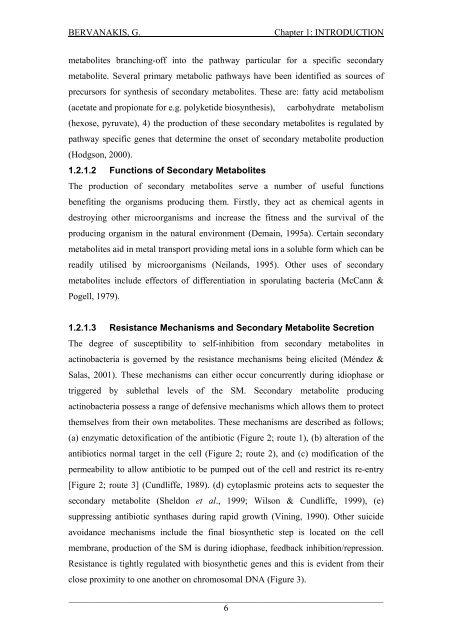Detection and Expression of Biosynthetic Genes in Actinobacteria ...
Detection and Expression of Biosynthetic Genes in Actinobacteria ...
Detection and Expression of Biosynthetic Genes in Actinobacteria ...
You also want an ePaper? Increase the reach of your titles
YUMPU automatically turns print PDFs into web optimized ePapers that Google loves.
BERVANAKIS, G.Chapter 1: INTRODUCTIONmetabolites branch<strong>in</strong>g-<strong>of</strong>f <strong>in</strong>to the pathway particular for a specific secondarymetabolite. Several primary metabolic pathways have been identified as sources <strong>of</strong>precursors for synthesis <strong>of</strong> secondary metabolites. These are: fatty acid metabolism(acetate <strong>and</strong> propionate for e.g. polyketide biosynthesis), carbohydrate metabolism(hexose, pyruvate), 4) the production <strong>of</strong> these secondary metabolites is regulated bypathway specific genes that determ<strong>in</strong>e the onset <strong>of</strong> secondary metabolite production(Hodgson, 2000).1.2.1.2 Functions <strong>of</strong> Secondary MetabolitesThe production <strong>of</strong> secondary metabolites serve a number <strong>of</strong> useful functionsbenefit<strong>in</strong>g the organisms produc<strong>in</strong>g them. Firstly, they act as chemical agents <strong>in</strong>destroy<strong>in</strong>g other microorganisms <strong>and</strong> <strong>in</strong>crease the fitness <strong>and</strong> the survival <strong>of</strong> theproduc<strong>in</strong>g organism <strong>in</strong> the natural environment (Dema<strong>in</strong>, 1995a). Certa<strong>in</strong> secondarymetabolites aid <strong>in</strong> metal transport provid<strong>in</strong>g metal ions <strong>in</strong> a soluble form which can bereadily utilised by microorganisms (Neil<strong>and</strong>s, 1995). Other uses <strong>of</strong> secondarymetabolites <strong>in</strong>clude effectors <strong>of</strong> differentiation <strong>in</strong> sporulat<strong>in</strong>g bacteria (McCann &Pogell, 1979).1.2.1.3 Resistance Mechanisms <strong>and</strong> Secondary Metabolite SecretionThe degree <strong>of</strong> susceptibility to self-<strong>in</strong>hibition from secondary metabolites <strong>in</strong>act<strong>in</strong>obacteria is governed by the resistance mechanisms be<strong>in</strong>g elicited (Méndez &Salas, 2001). These mechanisms can either occur concurrently dur<strong>in</strong>g idiophase ortriggered by sublethal levels <strong>of</strong> the SM. Secondary metabolite produc<strong>in</strong>gact<strong>in</strong>obacteria possess a range <strong>of</strong> defensive mechanisms which allows them to protectthemselves from their own metabolites. These mechanisms are described as follows;(a) enzymatic detoxification <strong>of</strong> the antibiotic (Figure 2; route 1), (b) alteration <strong>of</strong> theantibiotics normal target <strong>in</strong> the cell (Figure 2; route 2), <strong>and</strong> (c) modification <strong>of</strong> thepermeability to allow antibiotic to be pumped out <strong>of</strong> the cell <strong>and</strong> restrict its re-entry[Figure 2; route 3] (Cundliffe, 1989). (d) cytoplasmic prote<strong>in</strong>s acts to sequester thesecondary metabolite (Sheldon et al., 1999; Wilson & Cundliffe, 1999), (e)suppress<strong>in</strong>g antibiotic synthases dur<strong>in</strong>g rapid growth (V<strong>in</strong><strong>in</strong>g, 1990). Other suicideavoidance mechanisms <strong>in</strong>clude the f<strong>in</strong>al biosynthetic step is located on the cellmembrane, production <strong>of</strong> the SM is dur<strong>in</strong>g idiophase, feedback <strong>in</strong>hibition/repression.Resistance is tightly regulated with biosynthetic genes <strong>and</strong> this is evident from theirclose proximity to one another on chromosomal DNA (Figure 3)._____________________________________________________________________6















